Chapter 13: Positive Emotions
Facial Expressions and Cognitive Appraisals
Appraisal theorists have applied the Component Process Model (Scherer, 2001; for a review, go here) to determine how action units vary according to cognitive appraisal checks. This study was done by Scherer, who developed the CPM, and his colleagues (Mortillaro et al., 2011). They investigated the action unit changes for joy, pride, sensory pleasure, and interest. (Note: the researchers stated that sensory pleasure and interest may not meet the requirements for an emotion). In this study, 10 professional actors displayed each of the four feeling states – joy, pride, sensory pleasure, and interest. For each feeling state displayed, coders identified the presence of action units and how long the action units were displayed on the actors’ face. Overall, this study found that the action unit changes for pride and joy were the same and the action unit changes for interest and pleasure were the same (see Table 13). Thus, overall findings contrasted the differences in action unit changes for two groups – 1) Pride, Joy vs. 2) Interest, Sensory Pleasure. Table 13 displays the findings for each of the relevant action units. Remember, differences were not found between joy and pride OR between interest and sensory pleasure. Overall, the findings in Table 13 suggest that pride and joy results in more Duchenne smiling (AU 6 + 12) than interest and pleasure. But generally, these findings suggest that specific action units do not occur for specific discrete emotions. These findings may support Ekman’s (1992, 1993) theory that all positive emotions represent different intensities of the same positive emotion family.
Table 13
Differences in Action Unit Changes and Duration for Pride, Joy vs. Interest, Pleasure (Martillaro et al., 2011)
| Action Unit | Action Unit Description | Presence / Duration of Action Unit |
|---|---|---|
| 1 | Inner brow raiser
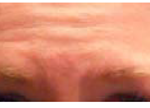 |
Present more in joy than pleasure |
| 2 | Outer brow raiser
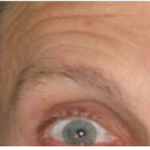 |
Present more in pride than pleasure |
| 6 | Cheek raiser
 |
|
| 7 | Lid tightener
 |
Longer duration for interest than joy |
| 12 | Lip corner puller
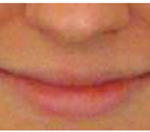 |
Shorter, more frequent smiles in pride vs. interest, pleasure; “small smile” present in pride (Tracy & Robins, 2004, 2008) |
| 17 | Chin Raiser
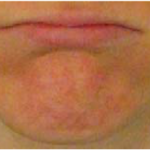 |
More in pride than pleasure |
Photos reproduced and adapted from “Subtly Different Positive Emotions Can Be Distinguished By Their Facial Expressions” by M. Mortillaro, M. Mehu, and K.R. Scherer, 2011, Social Psychological and Personality Science, 2(3), p. 265-266 (https://doi.org/10.1177/1948550610389080) Copyright 2011 by The Authors.
This study did not find any unique action unit changes to differentiate the four positive feeling states. So, the appraisal theorists explored whether the duration of certain action units corresponded to three cognitive appraisal dimensions from the CPM: 1) suddenness 2) intrinsic pleasantness, and 3) goal conduciveness.
The suddenness appraisal (Table 14) may be displayed in long durations of AU1 and AU2, which were present in interest and joy displays. Conversely, AU43 was displayed during pride and sensory pleasure, feelings that do not include a suddenness appraisal. Interestingly, the researchers view suddenness as occurring on a dimension from eyes being almost completely closed (AU 43) to eyes being wide open (AU 1+2 + 5). In other words, as shown in Figure 7, the amount of eye openness may be positively correlated with suddenness.
Table 14A
Relationship between Suddenness Appraisal and Duration of Action Unit Changes for High Suddenness
| Longer Duration of AU | AU Description | Emotions where the AU is Present |
|---|---|---|
| AU 1 | Inner Brow Raise
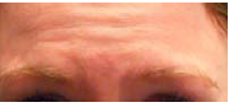 |
Interest, Joy |
| AU 2 | Outer Brow Raise
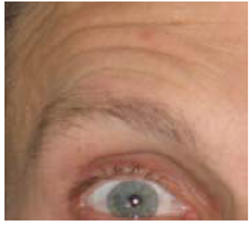 |
Interest, Joy |
| AU 5 | Upper Lid Raiser
 |
Interest, Joy |
Table 14B
Relationship between Suddenness Appraisal and Duration of Action Unit Changes for low Suddenness
| Longer Duration of AU | AU Description | Emotions where the AU is Present |
|---|---|---|
| AU 43 |
 |
Pride, Sensory Pleasure |
Figure 7
Correlational Relationship Between Suddenness Appraisal and Amount Eyes Opened
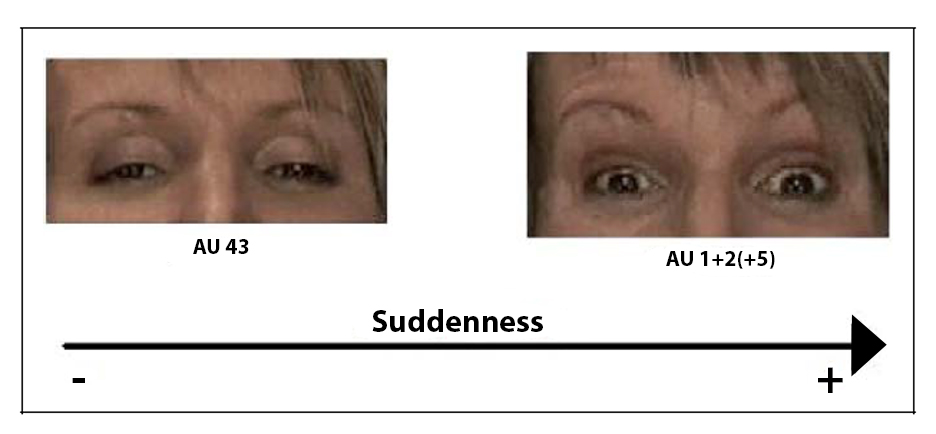
Reproduced from “Subtly Different Positive Emotions Can Be Distinguished By Their Facial Expressions,” by M. Mortillaro, M. Mehu, and K.R. Scherer, 2011, Social Psychological and Personality Science, 2(3), p. 265-266 (https://doi.org/10.1177/1948550610389080) Copyright 2011 by The Authors.
AU6 is present during the experience of intrinsic pleasantness – general feelings of positivity that exist early in the emotion episode (Table 15). AU6 is present during feeling states of joy and pleasure, but absent during feeling states of pride and interest. Thus, the authors believe AU6 might differentiate positive emotions that cause a joyful smile from positive emotions that cause other smiles, such as the small smile in pride. Interestingly, AU12 (lip corner puller) did not differentiate the four positive feeling states and in fact was present for all four feeling states. This suggests that AU12 may change when experiencing any positive emotion.
Table 15
Relationship between Intrinsic Pleasantness Appraisal and Presence of Action Unit Change
| High Intrinsic Pleasure | AU 6 |
 |
Joy, Pleasure |
Photos reproduced and adapted from “Subtly Different Positive Emotions Can Be Distinguished By Their Facial Expressions,” by M. Mortillaro, M. Mehu, and K.R. Scherer, 2011, Social Psychological and Personality Science, 2(3), p. 265-266 (https://doi.org/10.1177/1948550610389080) Copyright 2011 by The Authors.
Emotions caused by appraisals of goal conduciveness (e.g., joy, pride) were accompanied by long duration of action unit changes of 1+2+6 (Table 16). Positive emotions that do not help people achieve their goals (i.e., interest, sensory pleasure) were accompanied by longer duration action unit changes of 7 + 43. The researchers theorize that AU7 represents a state of focus or concentration.
Table 16
Relationship between Goal Conduciveness Appraisal and Duration of Action Unit Changes for High Goal Conduciveness
| Action Unit | AU Description | Emotions Present in |
|---|---|---|
| AU 1 | Inner Brow Raiser
 |
Joy, Pride |
| AU 2 | Outer Brow Raiser
 |
Joy, Pride |
| AU 6 | Cheek Raiser
 |
Joy, Pride |
Table 16 B
Relationship between Goal Conduciveness Appraisal and Duration of Action Unit Changes for Low Goal Conduciveness
| Action Unit | AU Description | Emotions Present in |
|---|---|---|
| AU 7 | Lid Tightener
 |
Interest, Pleasure |
| AU 43 | Eye Closure
 |
Interest, Pleasure |
Photos reproduced and adapted from “Subtly Different Positive Emotions Can Be Distinguished By Their Facial Expressions,” by M. Mortillaro, M. Mehu, and K.R. Scherer, 2011, Social Psychological and Personality Science, 2(3), p. 265-266 (https://doi.org/10.1177/1948550610389080) Copyright 2011 by The Authors.

